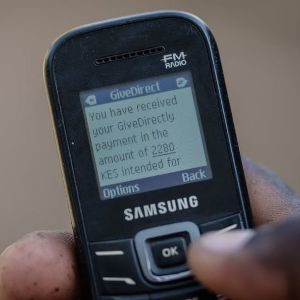Using AI and Digital Data to Target Cash Transfers in Togo

Hands of two African individuals doing financial transaction with a point of sales POS terminal as Nigerian Naira is exchanging hands. © kehinde – stock.adobe.com
Study Context
The COVID-19 pandemic devastated many low- and middle-income countries (LMICs), spurring the first increase in global extreme poverty in over two decades. The pandemic further highlighted challenges with traditional approaches to humanitarian response, which rely on expensive and slow manual process to enroll and pay beneficiaries.
Beginning in April 2020, CEGA co-Director Joshua Blumenstock began providing direct technical support to the government of Togo in response to the COVID-19 pandemic. In collaboration with Dean Karlan and Chris Udry from Northwestern University, Blumenstock’s team at CEGA and the Data-Intensive Development Lab is using mobile phone and satellite data to help identify the country’s most vulnerable individuals and disburse cash transfers to them through the government’s flagship social protection program, Novissi.
Study Design
The team first began by applying machine learning algorithms to high-resolution satellite imagery to develop micro-estimates of the relative wealth of every 2.4 km by 2.4 km region in Togo. This initial step relied on nationally representative survey data from 6,171 Togolese citizens collected before the start of the Covid-19 pandemic in 2018 and 2019. Using these data, the team built an algorithm that could predict relative wealth in Togo at a more granular level than the original survey: the 2.4km grid predictions were an improvement over the prefecture-level representative sample collected. The team leveraged the models to create initial poverty maps of rural Togo which helped inform the subsequent 2020 phone-based survey sampling strategy and provided the information needed for the Togolese government to geographically target Novissi to the 100 poorest cantons.
The research team buttressed this initial geographic targeting with an additional phone-based survey of a representative sample of 8,915 individual cell phone subscribers in September 2020. The sampling strategy inferred these individuals lived in rural cantons eligible for Novissi from their mobile phone data. As planned, this second survey provided researchers with a more accurate picture of canton-level individual variation in wealth and consumption; this provided the empirical base to train and validate the ML algorithms using cell phone data to predict an individual’s wealth from their mobile use. The research team matched both surveys’ responses to a separate CDR dataset obtained from Togo’s two mobile network operators.
Results and Policy Lessons
The research team developed algorithms optimized using high-dimensional CDR data to predict an individual’s wealth, using the survey data collected to validate its estimates. Blumenstock et al found that these algorithms performed quite well; they generated estimates that correlated strongly with survey and satellite-based estimates of wealth at the canton and prefecture level. Indeed, researchers calculated that this phone-based approach improved the precision of the social assistance program targeting by 42% relative to a naive geographic targeting of the 100 poorest cantons in Togo. Our government partners in the Togolese government then used the algorithm developed by the research team to calibrate Novissi in its second phase and scale up this phone-based approach in Togo. By incorporating this innovative targeting approach, the Togolese government provided unconditional cash transfers of $20 per month to 154,238 of its citizens in most need between December 2020 and April 2021 (around a third of the income of a Togolese earning minimum wage). For more information about the model, please consult the team’s Github repository and documentation.





